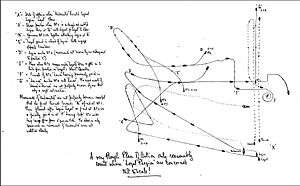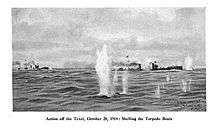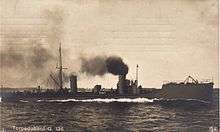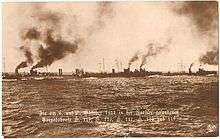Battle off Texel
| Battle off Texel | |||||||
|---|---|---|---|---|---|---|---|
| Part of the First World War | |||||||
 A sketch of the battle by one of the participants. | |||||||
| |||||||
| Belligerents | |||||||
|
|
| ||||||
| Commanders and leaders | |||||||
|
|
| ||||||
| Strength | |||||||
|
1 light cruiser, 4 destroyers | 4 torpedo boats[2] | ||||||
| Casualties and losses | |||||||
|
3 destroyers damaged 5 wounded |
4 torpedo-boats sunk 218 killed 30 Prisoners of war.[3] | ||||||
The Battle off Texel, also known as the Action off Texel or the Action of 17 October 1914, was a naval battle off the coast of the Dutch island of Texel during the First World War where a British squadron consisting of one light cruiser and four destroyers on a routine patrol encountered the remnants of the German 7th Half Flotilla of torpedo boats, which was en route to the British coast on a mission to lay minefields.[4][nb 1] The British forces attacked and sank the German flotilla of four torpedo boats. Outgunned, the German force attempted to flee and then fought a desperate and ineffective action against the British force.[5]
The battle resulted in the loss of the German torpedo boat squadron and prevented the mining of busy shipping lanes, such as the mouth of the Thames River. The British had few casualties and little damage to their vessels. The outcome of the battle also greatly influenced the tactics and deployments of the remaining German torpedo boat flotillas in the North Sea area, as the loss greatly shook the faith of the commanders in the effectiveness of the force.[6]
Background
After the opening naval Battle of Heligoland Bight, the German High Seas Fleet was ordered to avoid confrontations with larger opposing forces, to avoid costly and demoralizing reverses. Apart from occasional German raids, the North Sea was dominated by the Royal Navy which regularly patrolled the area, although German light forces operated regularly in North Sea.[7] At 13:50 on 17 October 1914, a routine patrol by the 3rd Destroyer Flotilla (Harwich Force) consisting of the light cruiser HMS Undaunted (Captain Cecil Fox) and four Laforey-class destroyers, HMS Lennox, Lance, Loyal and Legion, was cruising off the island of Texel, when they encountered a waiting German squadron of torpedo boats, comprising the remaining vessels of the 7th Half Flotilla (Korvettenkapitän Georg Thiele in S119) SMS S115, S117, S118.[nb 2] The German ships made no hostile move British ships, nor did they try to flee the scene and it was assumed by the British that they had mistaken the British ships for friendly vessels. The German flotilla had been sent out of the Ems River to mine the southern coast of Britain including the mouth of the Thames and had been intercepted before reaching its objective.[8]
The British squadron out-gunned the German 7th Half Flotilla, the Undaunted (Captain Cecil Fox, squadron commander)—an Arethusa-class light cruiser—was armed with two BL 6 inch Mk XII naval guns and seven QF 4 inch Mk V naval guns, in single mounts (most without gun shields) and eight torpedo tubes. Undaunted was experimentally armed with a pair of 2-pounder anti-aircraft guns, something most of her class lacked and at best speed could make 28.5 kn (32.8 mph; 52.8 km/h). The four Laforey-class destroyers were armed with two torpedo tubes, three 4-inch guns and a 2-pounder gun. The destroyers were slightly faster than the cruiser and could make about 29 knots (54 km/h; 33 mph) at full power.[9] The German vessels were inferior to the British in other areas, the 7th Half Flotilla was composed of ageing Großes Torpedoboot 1898 class and had been completed in 1904. The German boats were nearly equal in speed to the British at 28 knots (52 km/h; 32 mph).[10] Each of the German vessels was armed with three 50 mm (1.97 in) guns, that were of shorter range and throw-weight than the British guns. The biggest danger to the British squadron was the three 450 mm (17.7 in) torpedo tubes carried by each of the German boats, with five torpedoes per boat.[3]
Battle

Upon closer approach, the German vessels realized the nearby vessels were British and scattered, while Undaunted—which was closer to the Germans than the destroyers—opened fire on the nearest torpedo boat.[5] This German vessel managed to dodge the fire from Undaunted by changing course but lost speed and the British force caught up. To protect Undaunted from torpedo attack and to destroy the Germans as quickly as possible, Fox ordered the squadron to divide. Lance and Lennox chased S115 and S119 as Legion and Loyal pursued S117 and S118.[5] Fire from Legion, Loyal and Undaunted damaged S118 so badly that its bridge was blown off the deck, sinking her at 15:17. Lance and Lennox engaged S115, disabling her steering gear and causing the German vessel to circle. Lennox's fire was so effective that the bridge of S115 was also destroyed but the German torpedo-boat did not strike her colours.[10]

The two central boats in the German flotilla, S117 and the flotilla leader S119, tried to hit Undaunted with torpedoes; despite the torpedoes, Undaunted outmanoeuvred the German boats and remained unscathed.[10] When Legion and Loyal had finished off S118, they came to Undaunted's aid and engaged it's two attackers. Legion attacked S117, but it fired its last three torpedoes and continued to engage with gunfire. Legion pulverized S117, damaging her steering mechanism which forced her to circle before she was sunk at 15:30. At the same time, Lance and Lennox had damaged S115 to the point where only one of the destroyers was needed. Lance sjoined Loyal in bombarding S119 with lyddite shells.[5] S119 managed to fire a torpedo run at Lance and hit the destroyer amidships but the torpedo failed to detonate. S119 was sunk at 15:35 by gunfire from Lance and Loyal, taking the German flotilla commander down with it. S115 stayed afloat despite constant attacks from Lennox, which sent a boarding party, who found a wreck with only one German on board who happily surrendered. Thirty memners of the crew were eventually rescued from the sea by the British vessels.[10] The action ended at 16:30, with gunfire from Undaunted finishing off the abandoned hulk of S115.[5]
Aftermath
Analysis

The battle was seen as a great boost of morale for the British as two days previous, they had lost the cruiser HMS Hawke to a U-boat. The effect on British morale the battle had is reflected in its fictionalized and nationalistic inclusion in the 1915 dime novel The Boy Allies Under Two Flags, by Robert L. Drake.[11] Some controversy arose in Germany from the battle, because the German hospital ship Ophelia, which had been sent out to rescue survivors from the sunken boats, was seized by the British for violating the Hague Convention rules on the use of hospital ships.[12] The loss of a squadron of German torpedo boats, led to a drastic change in tactics in the English Channel and along the coast of Flanders. There were few sorties into the Channel and the torpedo boat force was relegated to coastal patrol and rescuing downed pilots.[6] The British received a bonus on 30 November, when a British fishing trawler pulled up the sealed chest thrown off S119 by Captain Thiele. The chest contained a German codebook used by the German light forces stationed on the coast, allowing the British to decipher German communications for long afterwards.[8]
Casualties
The four ships of the German Seventh Half Flotilla were sunk by Harwich Force and over two hundred sailors were killed including the commanding officer. Despite the odds no German vessel struck her colours and the Flotilla fought to the end. Only four British sailors were wounded, along with superficial damage to three of the destroyers.[13] Legion had one 4 lb (1.8 kg) shell hit and one man was wounded by machine-gun fire. Loyal was hit twice and had three or four men wounded as a result. Lance had superficial machine-gun damage and the other vessels were unscathed. Thirty-one German sailors were rescued from the water and the sinking ships and taken prisoner; a captured officer died of wounds soon after.[14] Two more German sailors were later rescued by a neutral vessel.[15]
Order of battle
Royal Navy
- HMS Undaunted, light cruiser, flagship
- HMS Lennox, destroyer
- HMS Lance, destroyer
- HMS Loyal, destroyer
- HMS Legion, destroyer
German Navy
- SMS S119, torpedo boat, flagship
- SMS S118, torpedo boat
- SMS S117, torpedo boat
- SMS S115, torpedo boat
Notes
Footnotes
- ↑ Some sources state that the German vessels were destroyers but all destroyer-like vessels were officially termed torpedo boats by the German Navy during World War I.
- ↑ S116 had also been a member of the 7th Half Flotilla but had been sunk by a British submarine some time before the Battle off Texel.
Citations
- ↑ Williamson, 9
- ↑ Halsey, 16
- 1 2 Groner, Eric (1990). German Warships 1815–1945: Major Surface Vessels I. Annapolis: Naval Institute Press. pp. 169–171. ISBN 0-87021-790-9.
- ↑ Scheer, 60
- 1 2 3 4 5 The Naval Review Volume V (PDF). London: The Naval Society. 1919. pp. 140–145.
- 1 2 Karau, Mark (2003). Wielding the Dagger. Westport: Praeger. pp. 44–58. ISBN 0-313-32475-1.
- ↑ Osborne, 90
- 1 2 Halpern, Paul G. (1995). A Naval History of World War I. Annapolis, MD: US Naval Institute Press. pp. 35–37. ISBN 1-55750-352-4.
- ↑ Jane's Fighting Ships of World War One (1919), Jane's Publishing Company
- 1 2 3 4 Wyllie, William Lionel (1918). Sea Fights of the Great War: Naval Incidents of the First Nine Months (PDF). London: The Naval Society. pp. 28–31. OCLC 2177843. Retrieved 21 January 2016.
- ↑ Drake, 15
- ↑ Scheer, 61
- ↑ British Victory at Sea. New York: New York Times. October 18, 1914. p. 1. ISSN 0362-4331. Retrieved 26 April 2010.
- ↑ Corbett, 224
- ↑ Drake, 15
References
- Corbett, J. S. (2009) [1938]. Naval Operations (PDF). History of the Great War based on Official Documents I (2nd rev. Imperial War Museum and Naval & Military Press repr. ed.). London: Longmans, Green. ISBN 1-84342-489-4. Retrieved 21 January 2016.
- Drake, Robert L. (2004) [1915]. The Boy Allies Under Two Flags (Gutenburg ed.). New York: A. L. Burt. OCLC 746986968. Retrieved 21 January 2016.
- Halsey, Francis (1920). The Literary Digest History of the World War X. New York and London: Funk and Wagnalls. OCLC 312834.
- Osborne, Eric (2004). Cruisers and Battle Cruisers: An Illustrated History of Their Impact (Weapons and Warfare). Santa Barbara, CA: ABC-CLIO. ISBN 1-85109-369-9.
- Scheer, Reinhard (1920). Germany's High Sea Fleet in the World War (PDF). London, New York, Toronto and Melbourne: Cassell. pp. 60–62. OCLC 2765294. Retrieved 21 January 2016.
- Williamson, Gordon (2003). German Destroyers 1939–45. Oxford: Osprey. ISBN 1-84176-504-X.
| ||||||||||||||||||||||||||||||||||||||||||||||||||||||||||||||||||||||||||||||||||||||||||||||||||||||||||||||
Coordinates: 53°17′21″N 3°28′27″E / 53.28917°N 3.47417°E